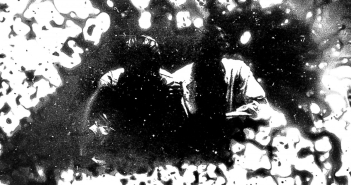The Final Report of the Commission of Investigation into Mother and Baby Homes has unleased another wave of soul-searching in Ireland. How could a society claiming to be ‘Christian’ have failed to protect, and even to have harmed, its most vulnerable – unmarried mothers and their ‘illegitimate’ children? The harrowing accounts fit within a wider ‘Theology of Incarceration’ that inculcated subservience and prevailed on the downtrodden to await their rewards in heaven.
‘The story of Matt Talbot is significant because it reflects the traditional approach of the Irish Catholic Church to the question of social justice’ wrote Ronan Sheehan in his seminal account of enduring exclusion in Ireland’s capital: The Heart Of The City by Ronan Sheehan and Brendan Walsh Brandon Books, (Dublin 1988); a second edition was published as Dublin: The Heart Of The City by Lilliput Press (Dublin, 2016).
Matt Talbot’s legacy continues to resonate through Dublin, and beyond: in the name of Talbot Street off O’Connell Street; and in one of its foremost bridges: the Talbot Memorial Bridge linking Memorial Road (and Custom House Quay) on the north bank of the river to Moss Street (and City Quay) on the south where there is a sculpture of Matt Talbot by James Power erected in 1978 and irreverently called ‘the pain with the chains.’ There is also a shrine to the ‘Venerable’ Matt Talbot’s inside the Neo-Romanesque Church of Our Lady of Lourdes on Sean McDermott Street dating from 1954, and a plaque on Granby Lane off Parnell Square.
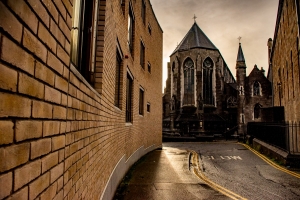
Granby Lane, Dublin 1.
Life and Death
The ascetic figure of Matt Talbot assumes centre stage in a chapter in Sheehan’s book entitled ‘Moral Issues and the Catholic Church’. After Talbot’s death in 1924 the example of his life would serve as propaganda for the Church. This posthumous status far exceeded any ambition in a humble working man, who drew solace from a profound religious conviction after struggling with alcohol addiction during his youth.
Sheehan recalls:
In his teens and twenties Talbot, like the other men in his family, drank heavily and was probably an alcoholic. Like the drug addicts of today the Talbots often stole to finance their habits and one occasion they took a street musician’s fiddle. Matt would pawn his boots for drinking money and walk barefoot. One day in 1884 after an idle week that had left them penniless, Matt and his brothers, Phil and Joe, stood outside a public house waiting to be invited inside for a drink. No one asked them ‘if they had a mouth on them’. Talbot went home and later that evening went to Clonliffe College where he took the pledge.
And so began Talbot’s recovery, engendering a moral rectitude that saw him repaying gambling debts and vainly searching for the fiddler whose instrument he had misappropriated. From that point onwards Talbot became a regular mass-goer at St. Saviour’s Dominican Priory on Upper Dorset Street. Indeed, it was while on his way to mass on nearby Granby Lane that he collapsed and died of heart failure. There is now a plaque dedicated to his memory at the site.
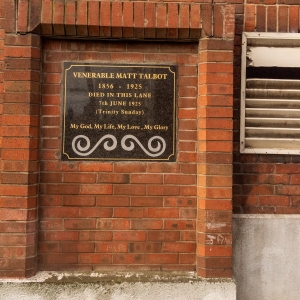
Plaque to Matt Talbot on Granby Lane.
Labourer and Ascetic
For much of his life Talbot worked as a labourer at a timber yard, at a time when workers’ movements were in ferment, and revolution in the air. Sheehan writes:
His [Talbot’s] relationship to the labour movement is a matter of dispute. He was on strike in 1900 and in the General Strike of 1913 and he was a member of the Irish Transport and General Workers Union. He refused to collect strike pay and when his colleagues pressed it on him, he gave the money to strikers with young families. Unusually for a Dublin man, he often admitted publicly that he could not understand issues and was prepared to be guided by people he felt were better informed. ‘Jim Larkin knows the rights and wrongs of it,’ he is quoted as saying with reference to the strike of 1913. Most frequently he referred issues to his spiritual advisors, or consulted texts they recommended.
Talbot’s mortification of the flesh included sleeping on a plank with block of wood for a pillow. Sheehan tells us that ‘When he died, in 1925, it was discovered that he had worn chains about his body.’ In death rather than life he would play an important role for the Irish Catholic Church: ‘Talbot’s subservient piety was adopted by the Church as a symbol in ideological crusades of the thirties, forties and fifties,’ and any deference to Jim Larkin’s methods would be obscured.

Our Lady of Lourdes on Sean McDermott Street, Dublin 1.
Irish Catholicism
A strong association between Church and State was perhaps predictable in a newly independent Ireland, given Catholicism’s role in preserving a distinctive Irish identity after the failure of the United Irishmen movement in the 1790s to bring lasting unity between Protestant, Catholic and Dissenter. Declining use of the native language after the Great Famine of the 1840s made religion an obvious point of distinction between ‘Catholic’ Irish and ‘Protestant’ English.
The Catholic basis of Irish nationalism was affirmed during the struggle for independence: the 1916 Easter Rising was consciously suffused with religious symbolism; and in its aftermath prominent Republican figures from Protestant backgrounds such as the Countess Markievicz, and Roger Casement converted to Catholicism.
After independence in 1922, devotion to the ‘one true Church, Apostolic and Universal’ crossed the political divide between the Pro- and Anti-Treaty Civil War factions of what became Fianna Fail (1926) and Fine Gael (1933).
In conformity with Catholic doctrine, in 1925 divorce was prohibited in Ireland, a bar that was only removed after a referendum in 1996; while in Dublin in March, 1925 – the year after Matt Talbot’s death – according to Sheehan, ‘the police mounted a massive raid on an area variously known as the kips, Monto, the digs, the village. This was the brothel zone.’
Moreover, the Constitution that came into force under Éamon de Valera in 1937 – and accepted by a majority of the electorate – identified a ‘special position’ for the Catholic Church, in an article only deleted after another referendum in 1972.
Right up until the 1990s – the revelation in 1992 that Bishop Eamon Casey had fathered a child with an American woman is often viewed as a pivotal moment – there was little challenge to the pre-eminence of a Church, which created a state within a state through the provision of education and health that brooked no opposition. Thus in 1951 a combination of the Church hierarchy and the medical profession scuppered the ambitions of Minister for Health Noel Browne to introduce a measure of universal health care through the Mother and Child Scheme.
In its aftermath then Taoiseach John A. Costello of Fine Gael announced unapologetically: ‘I am an Irishman second, I am a Catholic first, and I accept without qualification in all respects the teaching of the hierarchy and the church to which I belong.’ In truth, few among the political class would have demurred from Costello’s unequivocal deference to the Catholic hierarchy.
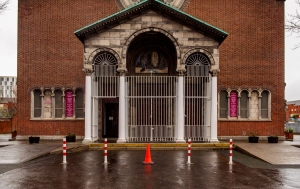
Our Lady of Lourdes on Sean McDermott Street, Dublin 1.
‘Dominion of Damnation’?
Nonetheless, Fintan O’Toole arguably goes too far in a recent assessment of the Church’s ‘Spiritual Terrorism’: ‘There was no such thing as ”society” as distinct from … dominion of damnation, no neutral State beyond its reach. It pervaded everything and invaded all of our bodies.’
For Irish men, at least, an independent caste of mind, and sense of humour, remained possible within fixed parameters. Building on the Irish Literary Revival, by the 1950s Dublin contained a remarkable artistic community, which included writers such as Flann O’Brien, Brendan Behan, Patrick Kavanagh and J.P. Dunleavy, while the gay artist Patrick Scott was emerging on the scene; meanwhile many Irish Republicans of that period were being influenced by Marxism, to the consternation of the Church.
Notwithstanding greater emphasis on social supports under Éamon de Valera’s Fianna Fail from 1932, including an ambitious house building programme; and the introduction from 1948 of Keynesian fiscal policies under Fine Gael’s John A. Costello – whose son Declan would develop the idea of Christian socialism within that party with his Just Society document – for most of the population even socialism remained a dirty word; while Communism was considered the work of the devil.
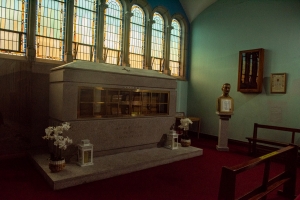
Shrine to the ‘Venerable’ Matt Talbot, Our Lady of Lourdes on Sean McDermott Street, Dublin 1.
Archbishop John Charles McQuaid
According to Ronan Sheehan, ‘The political message that the image of Talbot is supposed to communicate is that the working class is properly a subject class.’ This ‘theology of incarceration’ was expressed by Archbishop John Charles McQuaid in an introduction to the first full-length biography of Talbot:
Yet it will be seen that the author in setting out the main events of the life of the Dublin workman has helped us to understand the sanctity to which he ultimately attained. The evidence is of a very remarkable spirit, or rather, gift of prayer, the practice of self-denial in poverty and work, the habit of recollection in the presence of God, a very tender graciousness towards children and a deep love of the most Holy Mother of God … We cherish the hope that the Church may set the seal of her approval from the virtues that made this obscure and gentle workman an image, in our midst, in Dublin, of the Patron of the interior life, St Joseph.’
McQuaid’s unctuous benediction seems the realisation of W. B. Yeats’s concern about an emerging Ireland where ‘men were born to pray and save’; in political terms, as Sheehan, put it:
When proletarian energy is focused upon the ‘interior life’ it is rendered politically tame. In Talbot the class struggle for justice is replaced by an individual struggle for holiness. It is precisely because he was a worker that we can see in Talbot’s spirituality the epitome of the negative ideological role Marx and Engels attributed to religion.
Sheehan caustically observed: ‘Instead of attempting an analysis of the society in which he lived, he meditated.’
Through no fault of his own, the political quiescence of Matt Talbot produced an ideal role model for the Catholic Church of an uncomplaining working man, who awaits his reward in heaven. Importantly this was before the arrival of a Theology of Liberation in the wake of Vatican II that animated many Irish radicals in the 1960s, including the journalist Vincent Browne.
The importance of religious devotion to Talbot in his battle against alcoholism remains significant. Developing spiritual practices or a religious faith can often be beneficial to recovering addicts. However, Talbot’s apparent deference to authority as a working man suited the capitalist structures which the Catholic Church of that period legitimated.

Granby Lane, Dublin 1.
God after God?
A more activist Irish Catholicism infused with Liberation Theology is now closely associated with the continuing work of Father Peter McVerry, whose approach to poverty, according to Sheehan, ‘stands in contrast to that of the promoters of the cult of Matt Talbot.’
The philosopher Richard Kearney in his book Anatheism: Returning to God after God (Columbia, New York, 2010) proposes ‘the possibility of a third way beyond the extremes of dogmatic theism and militant atheism: those polar opposites of certainty that have maimed so many minds and souls in our history.’
Thus the Lutheran pastor Dietrich Bonhoeffer awaiting execution in a Nazi concentration camp for participating in a plot to kill Hitler proposed a reformed Christianity after the ‘Death of God’ heralded by Nietzsche, Freud and totalitarianism. Bonhoeffer wrote: ‘The God of religion, of metaphysics and of subjectivity is dead; the place is vacant for the preaching of the cross and for the God of Jesus Christ.’ To Kearney: ‘Christianity thus becomes not an invitation to another world but a call back to this one, a robust and challenging ‘Christianity of this world’, a secular faith that sees the weakness of God as precisely a summons to the rekindled strength of humanity.’
Throughout most of the history of the State Irish Catholicism reinforced a social order in which the working class were asked to count their blessings rather than their wages; while ‘fallen’ women and their progeny were treated with indifference and cruelty. A sanitized account of Matt Talbot’s life provided a useful lesson in subservience. Now that the spell is broken, it remains to be seen whether a Catholicism after Catholicism can yet emerge in Ireland.
All Images (c) Daniele Idini
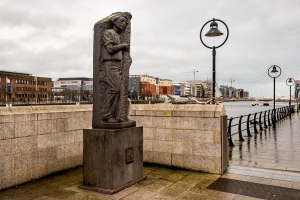
Statue of Matt Talbot on the south side of Matt Talbot Bridge.


